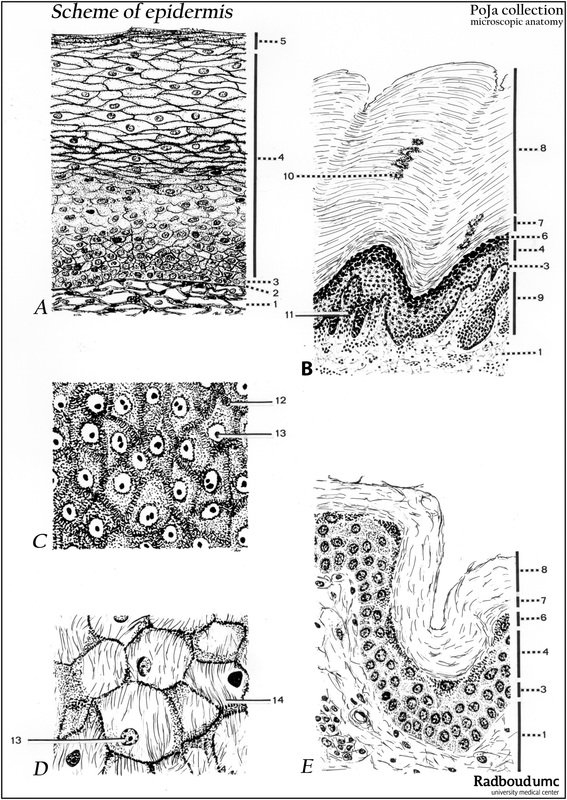10.2 POJA-L2081
Title: Scheme of different multilayered squamous epithelia in human
Description:
The skin (cutis) consists of the epidermis (multilayered keratinizing or cornifying squamous epithelium) and the connective tissue
of the dermis (corium with elastic and collagenous fibers). Underneath the dermis (subcutis) fat cells and glands are found.
(A): General survey of the non- cornifying squamous epidermis (esophagus):
(1) Loose connective tissue of the lamina propria.
(2) Basal membrane.
(3) Stratum basale where the cuboidal cells divide mitotically.
(4) Stratum spinosum.
(5) Slightly cornified superficial layer of cells.
(B): Thick skin (foot sole).
(1) Stratum papillare of the corium (connective tissue).
(3) Stratum basale with mitotic cells (stratum germinativum).
(4) Stratum spinosum with desmosomal connections.
(6) Stratum granulosum, a thin granulated layer with basophilic keratohyaline granules.
(7) Stratum lucidum, a thin shiny layer with densely packed keratin filaments.
(8) Stratum corneum, the outer cornified layer, being thick at the sole of the foot.
(9) Dermis or corium layer.
(10) Intraepidermal secretory ducts of the sweat glands.
(11) Dermal papillae, being folds to enlarge the anchoring area between epithelium and connective tissue.
(C, D): Detail of stratum spinosum. The cells of the stratum spinosum display numerous desmosomal connections (12) or bridges
in order to enforce the cohesion of the epithelial cells. It gives a stellate structure to the cell layer. These cells contain more cytokeratin filaments (14) than the basal cells, radiating from around the compact nucleus (13) to the desmosomes.
(E): Thin skin (axilla).
(1) Dermis (connective tissue).
(3) Stratum basale or stratum germinativum.
(4) Stratum spinosum. The name stratum of Malpighi is equivalent to stratum basale plus stratum spinosum.
(6) Stratum granulosum.
(7) Stratum lucidum.
(8) Stratum corneum.
Keywords/Mesh: skin, epidermis, dermis, foot sole, axilla, histology, POJA collection
Title: Scheme of different multilayered squamous epithelia in human
Description:
The skin (cutis) consists of the epidermis (multilayered keratinizing or cornifying squamous epithelium) and the connective tissue
of the dermis (corium with elastic and collagenous fibers). Underneath the dermis (subcutis) fat cells and glands are found.
(A): General survey of the non- cornifying squamous epidermis (esophagus):
(1) Loose connective tissue of the lamina propria.
(2) Basal membrane.
(3) Stratum basale where the cuboidal cells divide mitotically.
(4) Stratum spinosum.
(5) Slightly cornified superficial layer of cells.
(B): Thick skin (foot sole).
(1) Stratum papillare of the corium (connective tissue).
(3) Stratum basale with mitotic cells (stratum germinativum).
(4) Stratum spinosum with desmosomal connections.
(6) Stratum granulosum, a thin granulated layer with basophilic keratohyaline granules.
(7) Stratum lucidum, a thin shiny layer with densely packed keratin filaments.
(8) Stratum corneum, the outer cornified layer, being thick at the sole of the foot.
(9) Dermis or corium layer.
(10) Intraepidermal secretory ducts of the sweat glands.
(11) Dermal papillae, being folds to enlarge the anchoring area between epithelium and connective tissue.
(C, D): Detail of stratum spinosum. The cells of the stratum spinosum display numerous desmosomal connections (12) or bridges
in order to enforce the cohesion of the epithelial cells. It gives a stellate structure to the cell layer. These cells contain more cytokeratin filaments (14) than the basal cells, radiating from around the compact nucleus (13) to the desmosomes.
(E): Thin skin (axilla).
(1) Dermis (connective tissue).
(3) Stratum basale or stratum germinativum.
(4) Stratum spinosum. The name stratum of Malpighi is equivalent to stratum basale plus stratum spinosum.
(6) Stratum granulosum.
(7) Stratum lucidum.
(8) Stratum corneum.
Keywords/Mesh: skin, epidermis, dermis, foot sole, axilla, histology, POJA collection

